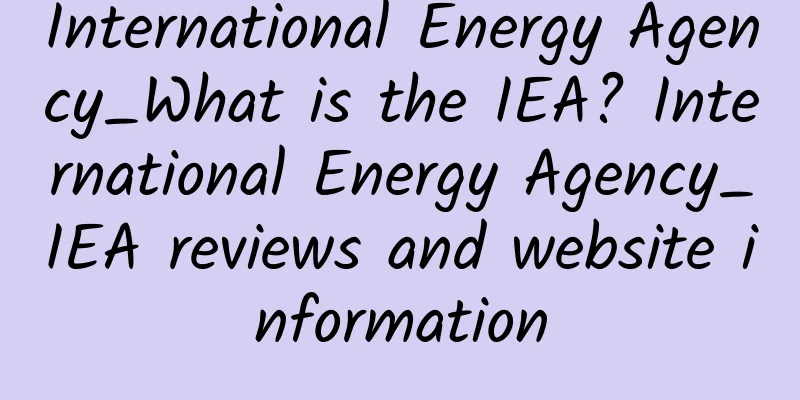International Energy Agency_What is the IEA? International Energy Agency_IEA reviews and website information

|
International Energy Agency_What is the IEA website? The International Energy Agency (IEA) is an intergovernmental international organization established by the Organization for Economic Cooperation and Development in 1974. Its secretariat is located in Paris, France. It is dedicated to energy security, economic development and environmental protection. Website: www.iea.org International Energy Agency (IEA): Pioneer in global energy governanceIn today's rapidly changing world, energy issues have become one of the core issues of concern to governments, businesses and the public. Whether it is climate change, energy security or economic development, energy plays a vital role. In this complex and dynamic field, the International Energy Agency (IEA), as an important institution in global energy governance, plays an irreplaceable role. The IEA was founded in 1974 to respond to the oil crisis at the time and ensure the security of energy supply for its member countries. However, over time, the IEA's mission has gone far beyond the original scope of energy security and expanded to include sustainable development, environmental protection, and technological innovation. Today, the IEA is not only an authoritative source of global energy data and analysis, but also a key force in promoting international cooperation, formulating policy recommendations, and promoting energy transformation. This article will explore the IEA's historical background, organizational structure, main functions and its role in global energy governance, and analyze its impact on energy policy through specific cases. At the same time, we will introduce the functions and resources of the IEA official website (www.iea.org) to help readers better understand the work of this international organization and its influence in the global energy field. IEA's historical background and original intentionTo understand the importance of the IEA, we first need to review its historical background and the original intention of its establishment. The oil crisis of 1973-1974 was the direct cause of the birth of the IEA. At that time, the Organization of Petroleum Exporting Countries (OPEC) implemented an oil embargo, which caused global oil prices to soar and many countries faced serious energy shortages. This situation exposed the vulnerability of developed countries in terms of energy supply, prompting the member countries of the Organization for Economic Cooperation and Development (OECD) to realize the necessity of establishing a coordination mechanism to jointly deal with the energy crisis. Therefore, in 1974, the IEA was established as an independent intergovernmental international organization. Its initial goal was very clear: to improve the security and stability of energy supply by strengthening cooperation among member countries. To this end, the IEA formulated an oil emergency plan, requiring member countries to reserve oil reserves equivalent to 90 days of net imports so that they can respond quickly in the event of an emergency. However, with the development of the times, the IEA's responsibilities have gradually expanded. Since the 1990s, the IEA has begun to pay attention to broader energy issues, such as renewable energy development, energy efficiency improvement, and climate change response. Especially after the signing of the Paris Agreement in 2015, the IEA has further strengthened its leadership in low-carbon transformation and sustainable development. IEA's organizational structure and operating modelAs an efficient international organization, the IEA's organizational structure has been carefully designed to ensure that it can flexibly respond to various challenges in the complex global energy environment. The IEA consists of four main components: Ministerial Conferences, the Board of Governors, the Secretariat and Technical Cooperation Programs.
The IEA's operating model emphasizes collaboration and transparency. It not only relies on financial support from member countries, but also expands its research scope and influence through cooperation with industry partners, academic institutions and other international organizations. In addition, the IEA regularly publishes public reports and data to provide valuable reference information for policymakers, researchers and the public. IEA's main functions and core tasksAs a leader in global energy governance, the IEA undertakes a number of key functions, which together constitute its core mission. The following is an overview of the IEA's main functions: 1. Energy securityEnsuring energy supply security has always been the IEA's top priority. To this end, the IEA has established a comprehensive oil emergency response mechanism and is constantly exploring new ways to enhance the energy resilience of its member countries. For example, the IEA assists member countries in developing energy emergency plans, monitors global oil market dynamics, and coordinates member countries to take joint actions during crises. In recent years, as the energy structure changes, the IEA has also turned its attention to the security of natural gas and other forms of energy. It helps member countries cope with increasingly complex energy security challenges by analyzing supply chain risks, assessing infrastructure vulnerabilities, and making recommendations for improvement. 2. Data and AnalysisThe IEA is well-known for its high-quality data and in-depth analysis. Its annual World Energy Outlook is regarded as the "Bible" for global energy policymakers. In addition, the IEA also provides detailed statistics on oil, natural gas, coal, renewable energy and energy efficiency, as well as special research reports on specific topics. These data and analyses not only provide a basis for decision-making for member states, but also provide valuable information resources for participants and researchers in the global energy market. 3. Sustainable developmentIn the face of the severe challenges of climate change, the IEA actively advocates the transition to a low-carbon economy. It helps countries achieve the goals of the Paris Agreement by developing roadmaps and policy recommendations. For example, the IEA proposed the "Net Zero Emissions by 2050 Scenario", which provides a clear path for how the global energy system can achieve net zero emissions by 2050. In addition, the IEA is committed to promoting the development of renewable energy and improving energy efficiency. Through technical cooperation projects and policy guidance, it supports member countries in overcoming technical barriers and institutional constraints and accelerating the application of clean energy technologies. 4. International cooperationThe IEA recognizes that solving global energy problems requires extensive cooperation. Therefore, it not only works closely with member countries, but also actively builds partnerships with non-member countries, international organizations and the private sector. For example, through the Association Programme, the IEA invites emerging economies such as China and India to participate in its activities and share experiences and best practices. In addition, the IEA maintains close ties with other international organizations such as the United Nations, the World Bank and the International Monetary Fund to jointly promote multilateral cooperation in global energy governance. The role of the IEA in global energy governanceOn the stage of global energy governance, the IEA plays multiple roles, including being a provider of data and information, a maker of policy recommendations, and a coordinator of international cooperation. The following is a detailed description of the important role of the IEA in global energy governance from several aspects: 1. Provide authoritative data and analysisAs an authoritative source of global energy data, IEA's data and analysis provide a scientific basis for policymakers. For example, the World Energy Outlook not only predicts energy development trends in the coming decades, but also assesses the potential impact of different policy options, helping governments make informed decisions. In addition, the IEA's real-time data platform (Energy Data Centre) provides market participants with timely energy market information, enhancing market transparency and efficiency. 2. Promote energy policy reformThe IEA helps member countries optimize their energy policy frameworks by issuing policy recommendations and best practice guidelines. For example, the IEA's Energy Policy Reviews series of reports comprehensively evaluates member countries' energy policies and makes specific recommendations for improvement. In the field of renewable energy, the IEA's technical cooperation projects provide technical support and experience sharing to member countries, helping them overcome technical and institutional barriers and accelerate the application of clean energy technologies. 3. Strengthen international cooperationThe IEA promotes dialogue and cooperation among its member countries by organizing international conferences, seminars and technical cooperation projects. For example, the IEA's Clean Energy Transitions Forum provides a communication platform for policymakers, industry leaders and experts and scholars from various countries to jointly discuss how to achieve low-carbon transformation. In addition, the IEA has also expanded its influence through cooperation with non-member countries. For example, the IEA has carried out a number of cooperation projects with China in the fields of renewable energy, energy efficiency and carbon capture and storage, and achieved remarkable results. 4. Addressing climate changeAs an important participant in addressing climate change, the IEA actively participates in the global climate governance process. It supports countries in achieving the goals of the Paris Agreement by formulating emission reduction targets and policy recommendations. For example, the "net zero emissions scenario" proposed by the IEA provides a clear path for the transformation of the global energy system and has been widely recognized. At the same time, the IEA also helps developing countries improve their ability to respond to climate change through technical cooperation projects and capacity building activities. IEA official website: www.iea.orgThe IEA's official website (www.iea.org) is an important window for understanding the organization's work and obtaining the latest information. This website not only provides a wealth of data and analysis resources, but also showcases the IEA's latest progress in energy security, sustainable development and international cooperation. 1. Data and StatisticsIn the "Data and Statistics" section, users can access comprehensive energy data and statistical information provided by the IEA. These data cover a variety of areas such as oil, natural gas, coal, renewable energy and energy efficiency, and are presented in the form of charts, tables and maps for easy understanding and analysis. In addition, the IEA also provides a real-time data platform (Energy Data Centre) that allows users to obtain the latest energy market dynamics information. 2. Reports and publicationsThe "Reports and Publications" section brings together all the important reports and research documents released by the IEA. These include the World Energy Outlook, Energy Policy Review, and various special research reports. These documents not only provide a basis for policymakers to make decisions, but also provide researchers and the public with an opportunity to gain a deeper understanding of energy issues. 3. News and EventsIn the "News and Events" section, users can learn about the latest developments and upcoming events of the IEA, including news releases, policy statements, international conferences and seminars, helping users to keep abreast of the latest trends and developments in the global energy sector. 4. About IEAThe "About IEA" section details the IEA's history, organizational structure, mission and vision. In addition, the section also provides information on the IEA's membership, partnerships and technical cooperation projects to help users fully understand this international organization. Conclusion: IEA’s future outlookAs an important pillar of global energy governance, the IEA has made remarkable achievements in the past 50 years. However, in the face of increasingly complex global energy challenges, the IEA still needs to continue to innovate and adapt to changes. In the future, IEA will continue to work in the following areas:
In short, as a pioneer in global energy governance, the IEA will continue to play a key role in future energy development and contribute to building a more secure, sustainable and inclusive energy future. |
<<: Bassaka Air - Bassaka Air Reviews and Website Information
>>: How is Korea's Koshin University? Korea's Koshin University reviews and website information
Recommend
How is Benali University College? Benali University College reviews and website information
What is Binary University College? Binary Universi...
The nutritional value of millet and the benefits of eating millet
Millet is a common food in life. Many people know...
Ingredients and methods of pumpkin bean paste balls
Fermented glutinous rice is also called sweet win...
How is Yihua Community? Yihua Community Reviews and Website Information
What is the Italian Chinese Community? Italian Chi...
How is King Games? King Games review and website information
What is King Games? King Digital Entertainment plc...
The efficacy and function of Sophora japonica The medicinal value of Sophora japonica
Sophora japonica is a kind of cardamom plant. Bot...
How is Teesside University in the UK? Teesside University reviews and website information
Teesside University is a modern university in the ...
The difference between Oyster mushroom and Phoenix mushroom
Mushrooms are a very good food and many people li...
The difference between azalea root and sunken wood, what is the function of sunken wood
People who like to raise fish must have heard of ...
How to make delicious pickled watermelon rind
People can’t live without watermelon in summer, b...
The efficacy, function and method of coriander
Coriander is a very extreme vegetable. Some peopl...
How is the Chinese Consulate General in Surabaya? Reviews and website information of the Chinese Consulate General in Surabaya
What is the website of the Chinese Consulate Gener...
What is the Metropolitan Museum of Art like? Metropolitan Museum of Art reviews and website information
What is the website of the Metropolitan Museum of ...
What is rock sugar snow pear? What are the effects and functions of rock sugar snow pear?
As the name implies, rock sugar and snow pear are...
How to make fig porridge
How much do you know about the recipe of fig porr...









